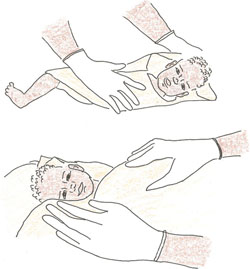
Before you look at the eight steps of essential newborn care (ENC) you need to remember the importance of the ‘three cleans’: clean hands, clean surface and clean equipment. Your equipment should include two clean dry towels, cord clamps, razor blade, cord tie, functional resuscitation equipment, vitamin K, syringe and needles, and tetracycline eye ointment.

Step 1 Deliver the baby onto the mother’s abdomen or a dry warm surface close to the mother.
Continue to support and reassure the mother. Tell her the sex of the baby and congratulate her.
Step 2 Dry the baby’s body with a dry warm towel as you try to stimulate breathing. Wrap the baby with another dry warm cloth and cover the head (Figure A).
Dry the baby well, including the head, immediately and then discard the wet cloth. Wipe the baby’s eyes. Rub up and down the baby’s back, using a clean, warm cloth. Drying often provides sufficient stimulation for breathing to start in mildly depressed newborn babies. Do your best not to remove the vernix (the creamy, white substance which may be on the skin) as it protects the skin and may help prevent infection. Then wrap the baby with another dry cloth and cover the head.
Step 3 Assess breathing and colour; if not breathing, gasping or there are less than 30 breaths per minute, then resuscitate.
As you dry the baby, assess its breathing. If a baby is breathing normally, both sides of the chest will rise and fall equally at around 30–60 times per minute. Thus, check if the baby is:
If the baby needs resuscitation, quickly clamp or tie and cut the cord, leaving a stump at least 10 cm long for now and then start resuscitation immediately. Functional resuscitation equipment should always be ready and close to the delivery area since you must start resuscitation within one minute of birth. It may sound as if you have a lot to do in one minute, but the steps described here are ones that you can take simultaneously. That is, while you are delivering the baby onto the mother’s abdomen and drying the baby, you can assess breathing and colour and take urgent action if necessary.
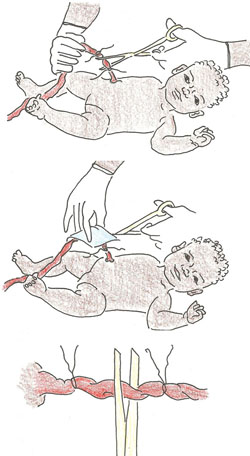
Step 4 Tie the cord two fingers’ length from the baby’s abdomen and make another tie two fingers from the first one (Figure B). Cut the cord between the first and second tie. If the baby needs resuscitation, cut the cord immediately. If not, wait for 7–3 minutes before cutting the cord.
Step 5 Place the baby in skin-to-skin contact with the mother, cover with a warm cloth and initiate breastfeeding.
The newborn loses heat in four ways (see Figure C below):
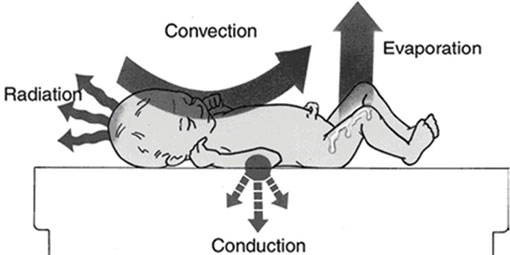
The warmth of the mother passes easily to the baby and helps stabilise the baby’s temperature.
The first skin-to-skin contact should last uninterrupted for at least one hour after birth or until after the first breastfeed. The baby should not be bathed at birth because a bath can cool the baby dangerously. After 24 hours, the baby can have the first sponge bath, if the temperature is stabilised.
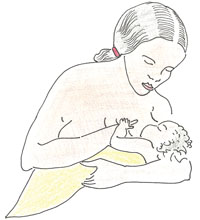
If everything is normal, the mother should immediately start breastfeeding.
For optimal breastfeeding you should do the following:
The steps to keep the newborn warm are called the warm chain.
Step 6 Give eye care (while the baby is held by its mother).
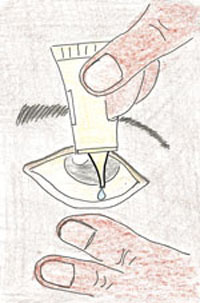
Shortly after breastfeeding and within one hour of being born, give the newborn eye care with an antimicrobial medication. Eye care protects the baby from serious eye infection which can result in blindness or even death.
The steps for giving the baby eye care are these:
First, wash your hands, and then using tetracycline 1% eye ointment:
Step 7 Give the baby vitamin K, 1 mg by intramuscular injection (IM) on the outside of the upper thigh (while the baby is held by its mother).
After following correct infection prevention steps, with the other hand stretch the skin on either side of the injection site and place the needle straight into the outside of the baby’s upper thigh (perpendicular to the skin). Then press the plunger to inject the medicine. You will be learning more about safe injection techniques in your practical skills training sessions.
Step 8 Weigh the baby.
Weigh the baby an hour after birth or after the first breastfeed. If the baby weighs less than 1,500 gm you must refer the mother and baby urgently.
Why do you need to give essential newborn care?
At birth the newborn must adapt quickly to life outside the uterus. As a trained health professional, you can take steps to ensure the baby is breathing well, kept warm and receives breastmilk from the mother.